Unit 44 - Control and integration of renewable energy sources
VerifiedAdded on 2023/01/19
|16
|3875
|38
AI Summary
Contribute Materials
Your contribution can guide someone’s learning journey. Share your
documents today.
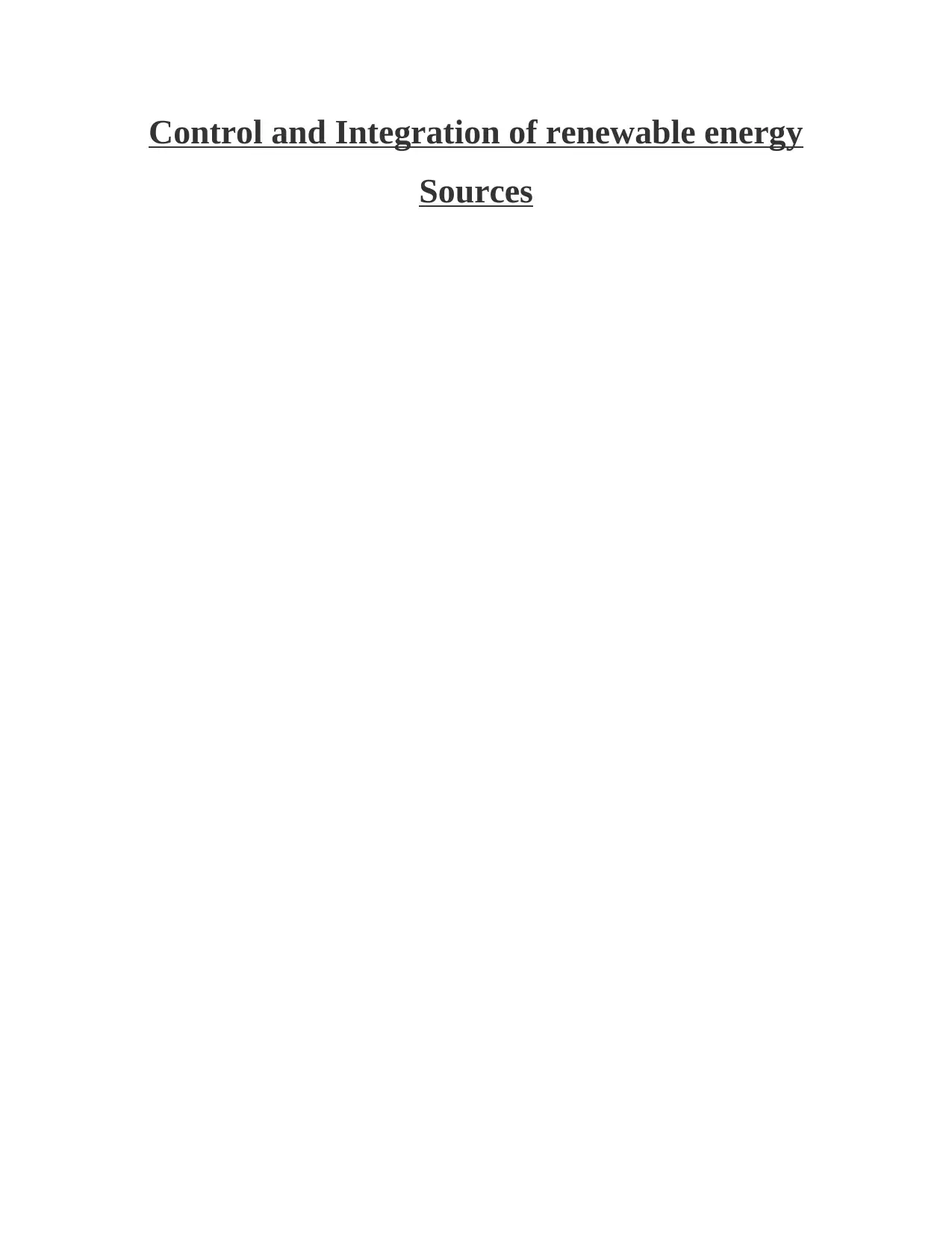
Control and Integration of renewable energy
Sources
Sources
Secure Best Marks with AI Grader
Need help grading? Try our AI Grader for instant feedback on your assignments.

Contents
INTRODUCTION...........................................................................................................................3
TASK 1............................................................................................................................................3
P1 Investigate about the current energy sources which demands impacts on environment........3
P2 understand about the benefits and effectiveness of renewable energy sources......................4
P3 Explore the renewable energy technologies and their costs...................................................4
TASK 2............................................................................................................................................5
P4 Describe the current solar energy efficiency measures..........................................................5
P5 Identify the main different factors which directly impact on the use of energy and
efficiency in building...................................................................................................................5
P6 Describe about the technologies that could be used to support more sustainable transport...6
TASK 3............................................................................................................................................6
P7 Demonstrate the applications of power electronics in renewable energy applications..........6
P8 Determine the industrial applications in terms of power electronic converters.....................7
P9 Understand about the power electronic converter topologies and its principles of operation.
.....................................................................................................................................................7
TASK 4............................................................................................................................................8
P10 Demonstrate the safe operation in terms of smart power system.........................................8
P11 Describe the principles of operation of standalone and grid connected renewable energy
systems.........................................................................................................................................9
P12 Identify the features of smart-grid network..........................................................................9
P13 Evaluate the importance of power electronics in smart grid and energy storage...............10
CONCLUSION..............................................................................................................................12
REFERENCES..............................................................................................................................13
INTRODUCTION...........................................................................................................................3
TASK 1............................................................................................................................................3
P1 Investigate about the current energy sources which demands impacts on environment........3
P2 understand about the benefits and effectiveness of renewable energy sources......................4
P3 Explore the renewable energy technologies and their costs...................................................4
TASK 2............................................................................................................................................5
P4 Describe the current solar energy efficiency measures..........................................................5
P5 Identify the main different factors which directly impact on the use of energy and
efficiency in building...................................................................................................................5
P6 Describe about the technologies that could be used to support more sustainable transport...6
TASK 3............................................................................................................................................6
P7 Demonstrate the applications of power electronics in renewable energy applications..........6
P8 Determine the industrial applications in terms of power electronic converters.....................7
P9 Understand about the power electronic converter topologies and its principles of operation.
.....................................................................................................................................................7
TASK 4............................................................................................................................................8
P10 Demonstrate the safe operation in terms of smart power system.........................................8
P11 Describe the principles of operation of standalone and grid connected renewable energy
systems.........................................................................................................................................9
P12 Identify the features of smart-grid network..........................................................................9
P13 Evaluate the importance of power electronics in smart grid and energy storage...............10
CONCLUSION..............................................................................................................................12
REFERENCES..............................................................................................................................13
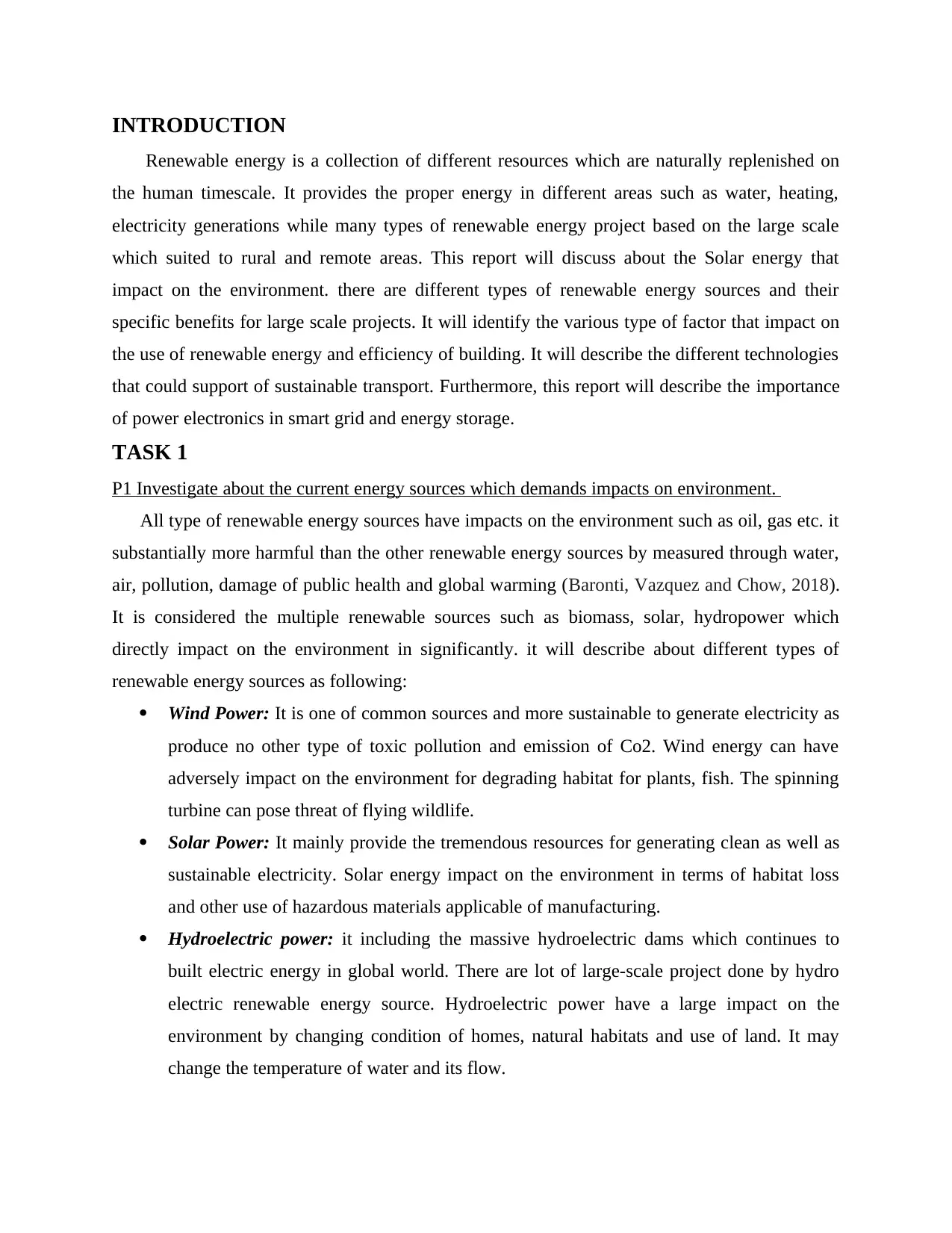
INTRODUCTION
Renewable energy is a collection of different resources which are naturally replenished on
the human timescale. It provides the proper energy in different areas such as water, heating,
electricity generations while many types of renewable energy project based on the large scale
which suited to rural and remote areas. This report will discuss about the Solar energy that
impact on the environment. there are different types of renewable energy sources and their
specific benefits for large scale projects. It will identify the various type of factor that impact on
the use of renewable energy and efficiency of building. It will describe the different technologies
that could support of sustainable transport. Furthermore, this report will describe the importance
of power electronics in smart grid and energy storage.
TASK 1
P1 Investigate about the current energy sources which demands impacts on environment.
All type of renewable energy sources have impacts on the environment such as oil, gas etc. it
substantially more harmful than the other renewable energy sources by measured through water,
air, pollution, damage of public health and global warming (Baronti, Vazquez and Chow, 2018).
It is considered the multiple renewable sources such as biomass, solar, hydropower which
directly impact on the environment in significantly. it will describe about different types of
renewable energy sources as following:
Wind Power: It is one of common sources and more sustainable to generate electricity as
produce no other type of toxic pollution and emission of Co2. Wind energy can have
adversely impact on the environment for degrading habitat for plants, fish. The spinning
turbine can pose threat of flying wildlife.
Solar Power: It mainly provide the tremendous resources for generating clean as well as
sustainable electricity. Solar energy impact on the environment in terms of habitat loss
and other use of hazardous materials applicable of manufacturing.
Hydroelectric power: it including the massive hydroelectric dams which continues to
built electric energy in global world. There are lot of large-scale project done by hydro
electric renewable energy source. Hydroelectric power have a large impact on the
environment by changing condition of homes, natural habitats and use of land. It may
change the temperature of water and its flow.
Renewable energy is a collection of different resources which are naturally replenished on
the human timescale. It provides the proper energy in different areas such as water, heating,
electricity generations while many types of renewable energy project based on the large scale
which suited to rural and remote areas. This report will discuss about the Solar energy that
impact on the environment. there are different types of renewable energy sources and their
specific benefits for large scale projects. It will identify the various type of factor that impact on
the use of renewable energy and efficiency of building. It will describe the different technologies
that could support of sustainable transport. Furthermore, this report will describe the importance
of power electronics in smart grid and energy storage.
TASK 1
P1 Investigate about the current energy sources which demands impacts on environment.
All type of renewable energy sources have impacts on the environment such as oil, gas etc. it
substantially more harmful than the other renewable energy sources by measured through water,
air, pollution, damage of public health and global warming (Baronti, Vazquez and Chow, 2018).
It is considered the multiple renewable sources such as biomass, solar, hydropower which
directly impact on the environment in significantly. it will describe about different types of
renewable energy sources as following:
Wind Power: It is one of common sources and more sustainable to generate electricity as
produce no other type of toxic pollution and emission of Co2. Wind energy can have
adversely impact on the environment for degrading habitat for plants, fish. The spinning
turbine can pose threat of flying wildlife.
Solar Power: It mainly provide the tremendous resources for generating clean as well as
sustainable electricity. Solar energy impact on the environment in terms of habitat loss
and other use of hazardous materials applicable of manufacturing.
Hydroelectric power: it including the massive hydroelectric dams which continues to
built electric energy in global world. There are lot of large-scale project done by hydro
electric renewable energy source. Hydroelectric power have a large impact on the
environment by changing condition of homes, natural habitats and use of land. It may
change the temperature of water and its flow.
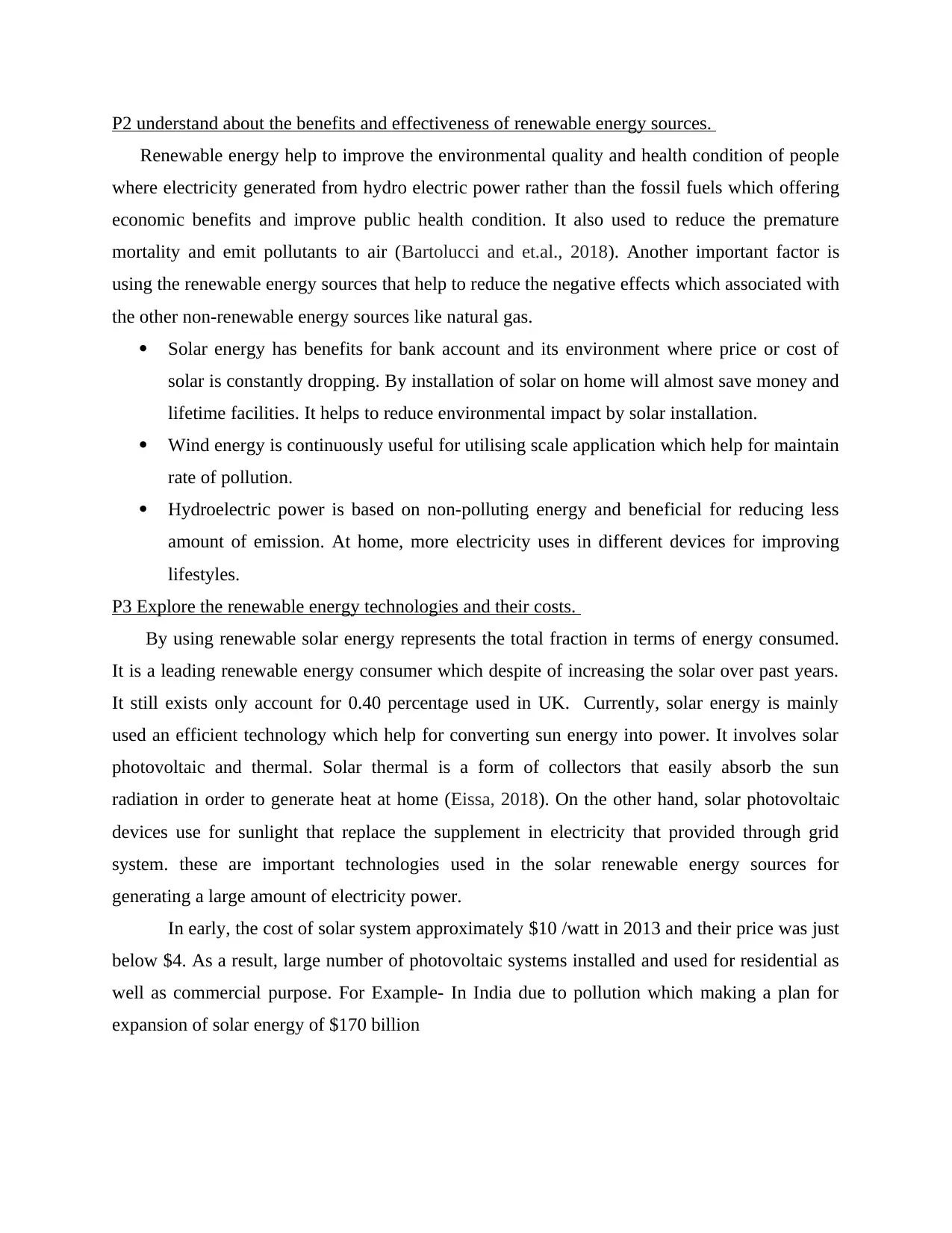
P2 understand about the benefits and effectiveness of renewable energy sources.
Renewable energy help to improve the environmental quality and health condition of people
where electricity generated from hydro electric power rather than the fossil fuels which offering
economic benefits and improve public health condition. It also used to reduce the premature
mortality and emit pollutants to air (Bartolucci and et.al., 2018). Another important factor is
using the renewable energy sources that help to reduce the negative effects which associated with
the other non-renewable energy sources like natural gas.
Solar energy has benefits for bank account and its environment where price or cost of
solar is constantly dropping. By installation of solar on home will almost save money and
lifetime facilities. It helps to reduce environmental impact by solar installation.
Wind energy is continuously useful for utilising scale application which help for maintain
rate of pollution.
Hydroelectric power is based on non-polluting energy and beneficial for reducing less
amount of emission. At home, more electricity uses in different devices for improving
lifestyles.
P3 Explore the renewable energy technologies and their costs.
By using renewable solar energy represents the total fraction in terms of energy consumed.
It is a leading renewable energy consumer which despite of increasing the solar over past years.
It still exists only account for 0.40 percentage used in UK. Currently, solar energy is mainly
used an efficient technology which help for converting sun energy into power. It involves solar
photovoltaic and thermal. Solar thermal is a form of collectors that easily absorb the sun
radiation in order to generate heat at home (Eissa, 2018). On the other hand, solar photovoltaic
devices use for sunlight that replace the supplement in electricity that provided through grid
system. these are important technologies used in the solar renewable energy sources for
generating a large amount of electricity power.
In early, the cost of solar system approximately $10 /watt in 2013 and their price was just
below $4. As a result, large number of photovoltaic systems installed and used for residential as
well as commercial purpose. For Example- In India due to pollution which making a plan for
expansion of solar energy of $170 billion
Renewable energy help to improve the environmental quality and health condition of people
where electricity generated from hydro electric power rather than the fossil fuels which offering
economic benefits and improve public health condition. It also used to reduce the premature
mortality and emit pollutants to air (Bartolucci and et.al., 2018). Another important factor is
using the renewable energy sources that help to reduce the negative effects which associated with
the other non-renewable energy sources like natural gas.
Solar energy has benefits for bank account and its environment where price or cost of
solar is constantly dropping. By installation of solar on home will almost save money and
lifetime facilities. It helps to reduce environmental impact by solar installation.
Wind energy is continuously useful for utilising scale application which help for maintain
rate of pollution.
Hydroelectric power is based on non-polluting energy and beneficial for reducing less
amount of emission. At home, more electricity uses in different devices for improving
lifestyles.
P3 Explore the renewable energy technologies and their costs.
By using renewable solar energy represents the total fraction in terms of energy consumed.
It is a leading renewable energy consumer which despite of increasing the solar over past years.
It still exists only account for 0.40 percentage used in UK. Currently, solar energy is mainly
used an efficient technology which help for converting sun energy into power. It involves solar
photovoltaic and thermal. Solar thermal is a form of collectors that easily absorb the sun
radiation in order to generate heat at home (Eissa, 2018). On the other hand, solar photovoltaic
devices use for sunlight that replace the supplement in electricity that provided through grid
system. these are important technologies used in the solar renewable energy sources for
generating a large amount of electricity power.
In early, the cost of solar system approximately $10 /watt in 2013 and their price was just
below $4. As a result, large number of photovoltaic systems installed and used for residential as
well as commercial purpose. For Example- In India due to pollution which making a plan for
expansion of solar energy of $170 billion
Secure Best Marks with AI Grader
Need help grading? Try our AI Grader for instant feedback on your assignments.
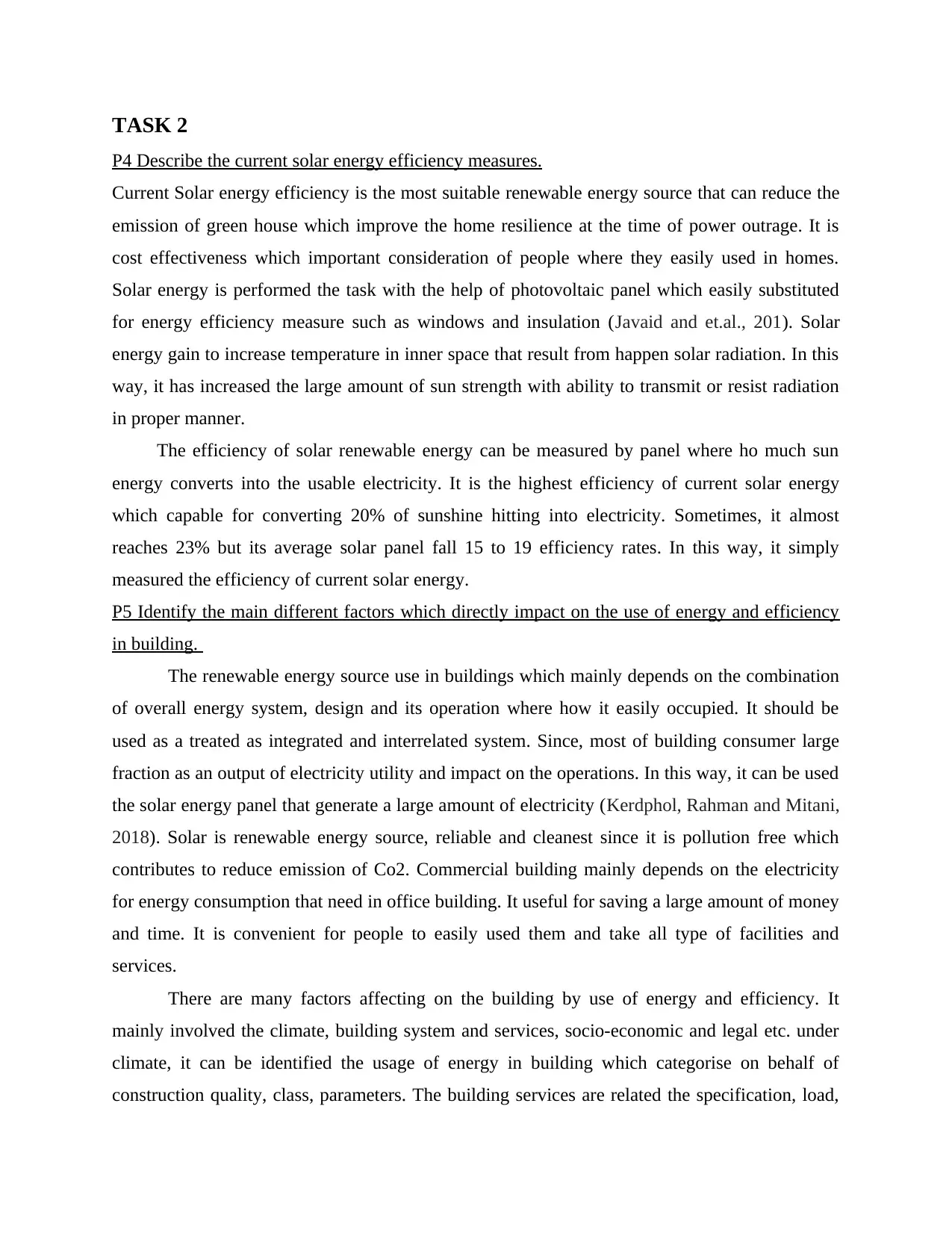
TASK 2
P4 Describe the current solar energy efficiency measures.
Current Solar energy efficiency is the most suitable renewable energy source that can reduce the
emission of green house which improve the home resilience at the time of power outrage. It is
cost effectiveness which important consideration of people where they easily used in homes.
Solar energy is performed the task with the help of photovoltaic panel which easily substituted
for energy efficiency measure such as windows and insulation (Javaid and et.al., 201). Solar
energy gain to increase temperature in inner space that result from happen solar radiation. In this
way, it has increased the large amount of sun strength with ability to transmit or resist radiation
in proper manner.
The efficiency of solar renewable energy can be measured by panel where ho much sun
energy converts into the usable electricity. It is the highest efficiency of current solar energy
which capable for converting 20% of sunshine hitting into electricity. Sometimes, it almost
reaches 23% but its average solar panel fall 15 to 19 efficiency rates. In this way, it simply
measured the efficiency of current solar energy.
P5 Identify the main different factors which directly impact on the use of energy and efficiency
in building.
The renewable energy source use in buildings which mainly depends on the combination
of overall energy system, design and its operation where how it easily occupied. It should be
used as a treated as integrated and interrelated system. Since, most of building consumer large
fraction as an output of electricity utility and impact on the operations. In this way, it can be used
the solar energy panel that generate a large amount of electricity (Kerdphol, Rahman and Mitani,
2018). Solar is renewable energy source, reliable and cleanest since it is pollution free which
contributes to reduce emission of Co2. Commercial building mainly depends on the electricity
for energy consumption that need in office building. It useful for saving a large amount of money
and time. It is convenient for people to easily used them and take all type of facilities and
services.
There are many factors affecting on the building by use of energy and efficiency. It
mainly involved the climate, building system and services, socio-economic and legal etc. under
climate, it can be identified the usage of energy in building which categorise on behalf of
construction quality, class, parameters. The building services are related the specification, load,
P4 Describe the current solar energy efficiency measures.
Current Solar energy efficiency is the most suitable renewable energy source that can reduce the
emission of green house which improve the home resilience at the time of power outrage. It is
cost effectiveness which important consideration of people where they easily used in homes.
Solar energy is performed the task with the help of photovoltaic panel which easily substituted
for energy efficiency measure such as windows and insulation (Javaid and et.al., 201). Solar
energy gain to increase temperature in inner space that result from happen solar radiation. In this
way, it has increased the large amount of sun strength with ability to transmit or resist radiation
in proper manner.
The efficiency of solar renewable energy can be measured by panel where ho much sun
energy converts into the usable electricity. It is the highest efficiency of current solar energy
which capable for converting 20% of sunshine hitting into electricity. Sometimes, it almost
reaches 23% but its average solar panel fall 15 to 19 efficiency rates. In this way, it simply
measured the efficiency of current solar energy.
P5 Identify the main different factors which directly impact on the use of energy and efficiency
in building.
The renewable energy source use in buildings which mainly depends on the combination
of overall energy system, design and its operation where how it easily occupied. It should be
used as a treated as integrated and interrelated system. Since, most of building consumer large
fraction as an output of electricity utility and impact on the operations. In this way, it can be used
the solar energy panel that generate a large amount of electricity (Kerdphol, Rahman and Mitani,
2018). Solar is renewable energy source, reliable and cleanest since it is pollution free which
contributes to reduce emission of Co2. Commercial building mainly depends on the electricity
for energy consumption that need in office building. It useful for saving a large amount of money
and time. It is convenient for people to easily used them and take all type of facilities and
services.
There are many factors affecting on the building by use of energy and efficiency. It
mainly involved the climate, building system and services, socio-economic and legal etc. under
climate, it can be identified the usage of energy in building which categorise on behalf of
construction quality, class, parameters. The building services are related the specification, load,
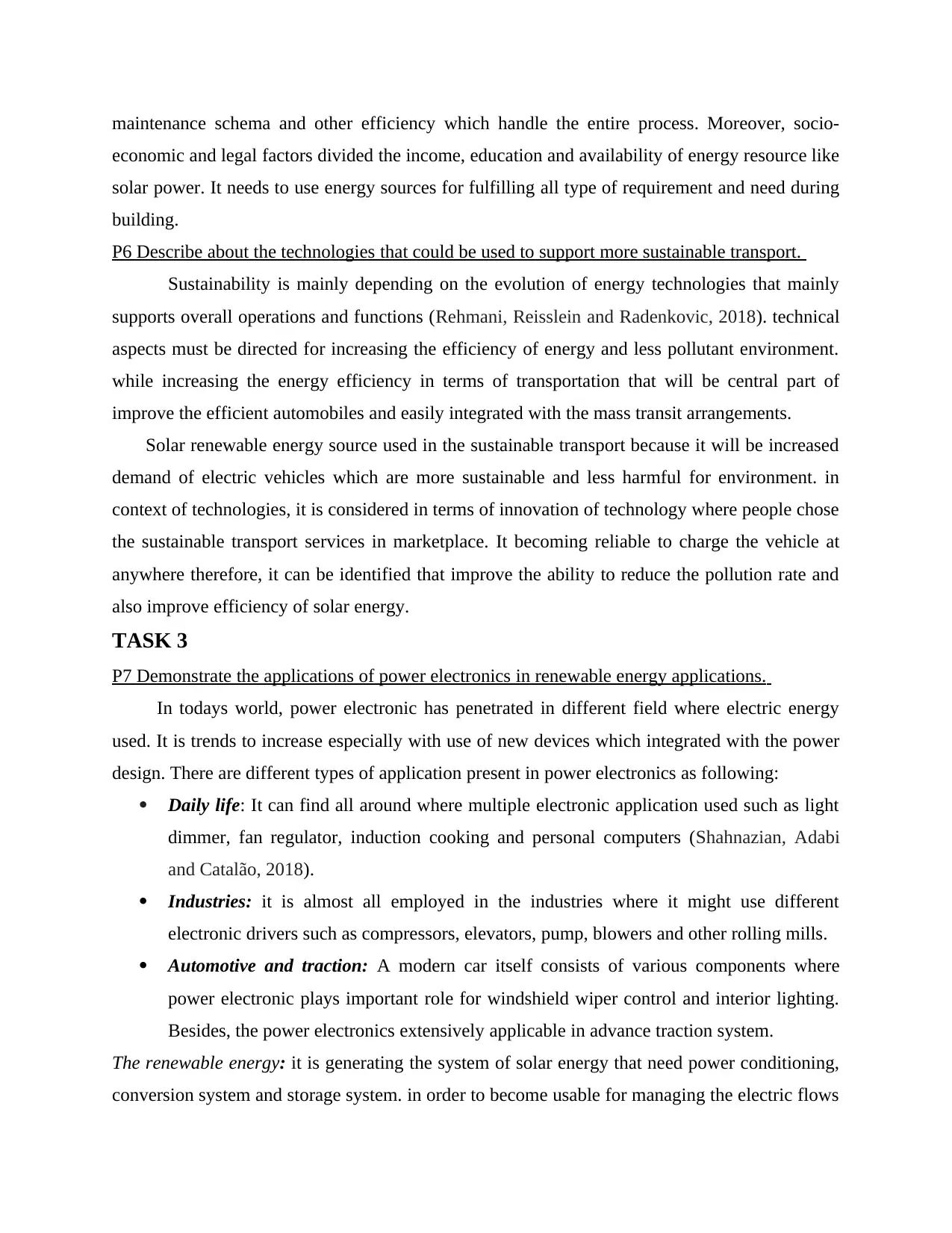
maintenance schema and other efficiency which handle the entire process. Moreover, socio-
economic and legal factors divided the income, education and availability of energy resource like
solar power. It needs to use energy sources for fulfilling all type of requirement and need during
building.
P6 Describe about the technologies that could be used to support more sustainable transport.
Sustainability is mainly depending on the evolution of energy technologies that mainly
supports overall operations and functions (Rehmani, Reisslein and Radenkovic, 2018). technical
aspects must be directed for increasing the efficiency of energy and less pollutant environment.
while increasing the energy efficiency in terms of transportation that will be central part of
improve the efficient automobiles and easily integrated with the mass transit arrangements.
Solar renewable energy source used in the sustainable transport because it will be increased
demand of electric vehicles which are more sustainable and less harmful for environment. in
context of technologies, it is considered in terms of innovation of technology where people chose
the sustainable transport services in marketplace. It becoming reliable to charge the vehicle at
anywhere therefore, it can be identified that improve the ability to reduce the pollution rate and
also improve efficiency of solar energy.
TASK 3
P7 Demonstrate the applications of power electronics in renewable energy applications.
In todays world, power electronic has penetrated in different field where electric energy
used. It is trends to increase especially with use of new devices which integrated with the power
design. There are different types of application present in power electronics as following:
Daily life: It can find all around where multiple electronic application used such as light
dimmer, fan regulator, induction cooking and personal computers (Shahnazian, Adabi
and Catalão, 2018).
Industries: it is almost all employed in the industries where it might use different
electronic drivers such as compressors, elevators, pump, blowers and other rolling mills.
Automotive and traction: A modern car itself consists of various components where
power electronic plays important role for windshield wiper control and interior lighting.
Besides, the power electronics extensively applicable in advance traction system.
The renewable energy: it is generating the system of solar energy that need power conditioning,
conversion system and storage system. in order to become usable for managing the electric flows
economic and legal factors divided the income, education and availability of energy resource like
solar power. It needs to use energy sources for fulfilling all type of requirement and need during
building.
P6 Describe about the technologies that could be used to support more sustainable transport.
Sustainability is mainly depending on the evolution of energy technologies that mainly
supports overall operations and functions (Rehmani, Reisslein and Radenkovic, 2018). technical
aspects must be directed for increasing the efficiency of energy and less pollutant environment.
while increasing the energy efficiency in terms of transportation that will be central part of
improve the efficient automobiles and easily integrated with the mass transit arrangements.
Solar renewable energy source used in the sustainable transport because it will be increased
demand of electric vehicles which are more sustainable and less harmful for environment. in
context of technologies, it is considered in terms of innovation of technology where people chose
the sustainable transport services in marketplace. It becoming reliable to charge the vehicle at
anywhere therefore, it can be identified that improve the ability to reduce the pollution rate and
also improve efficiency of solar energy.
TASK 3
P7 Demonstrate the applications of power electronics in renewable energy applications.
In todays world, power electronic has penetrated in different field where electric energy
used. It is trends to increase especially with use of new devices which integrated with the power
design. There are different types of application present in power electronics as following:
Daily life: It can find all around where multiple electronic application used such as light
dimmer, fan regulator, induction cooking and personal computers (Shahnazian, Adabi
and Catalão, 2018).
Industries: it is almost all employed in the industries where it might use different
electronic drivers such as compressors, elevators, pump, blowers and other rolling mills.
Automotive and traction: A modern car itself consists of various components where
power electronic plays important role for windshield wiper control and interior lighting.
Besides, the power electronics extensively applicable in advance traction system.
The renewable energy: it is generating the system of solar energy that need power conditioning,
conversion system and storage system. in order to become usable for managing the electric flows
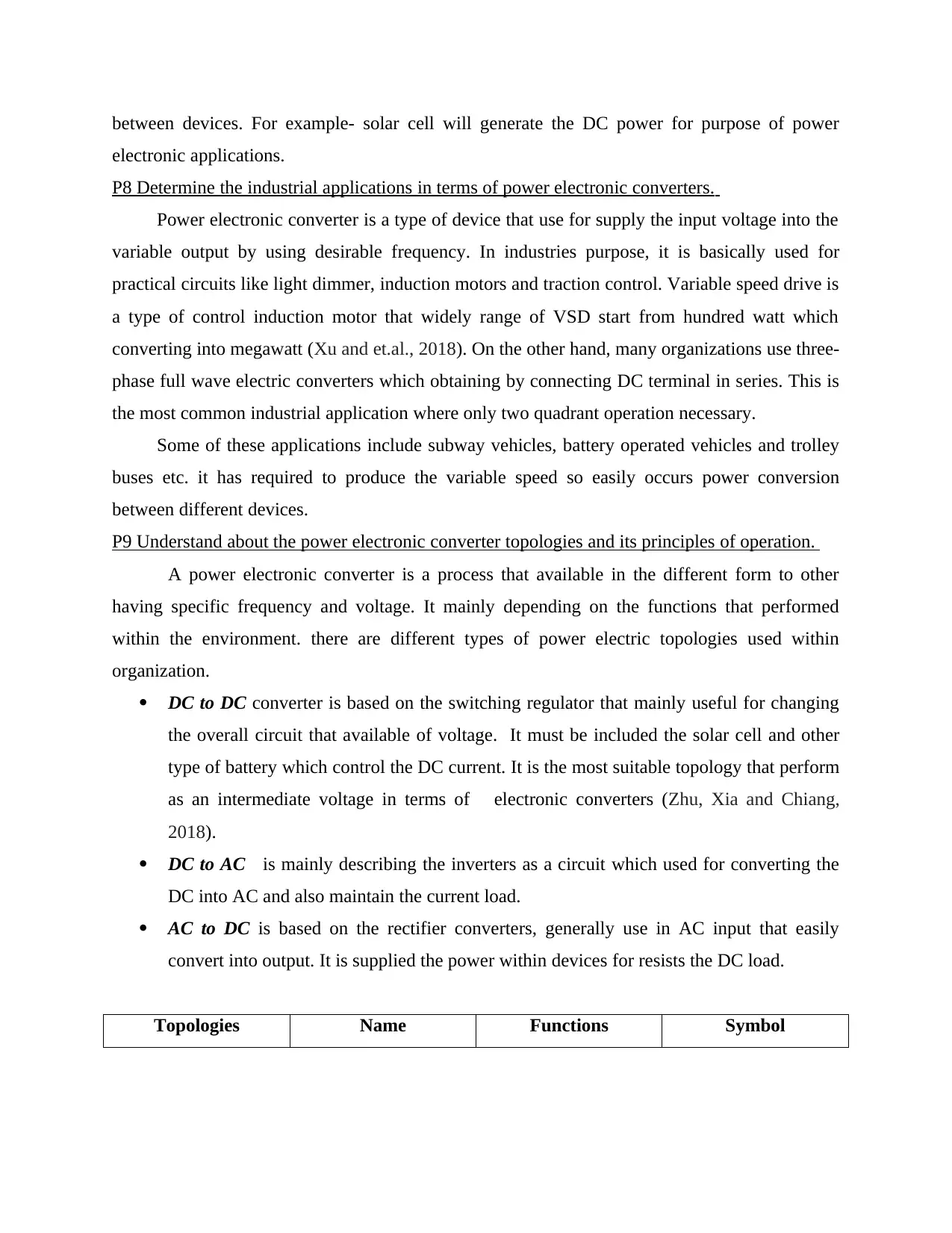
between devices. For example- solar cell will generate the DC power for purpose of power
electronic applications.
P8 Determine the industrial applications in terms of power electronic converters.
Power electronic converter is a type of device that use for supply the input voltage into the
variable output by using desirable frequency. In industries purpose, it is basically used for
practical circuits like light dimmer, induction motors and traction control. Variable speed drive is
a type of control induction motor that widely range of VSD start from hundred watt which
converting into megawatt (Xu and et.al., 2018). On the other hand, many organizations use three-
phase full wave electric converters which obtaining by connecting DC terminal in series. This is
the most common industrial application where only two quadrant operation necessary.
Some of these applications include subway vehicles, battery operated vehicles and trolley
buses etc. it has required to produce the variable speed so easily occurs power conversion
between different devices.
P9 Understand about the power electronic converter topologies and its principles of operation.
A power electronic converter is a process that available in the different form to other
having specific frequency and voltage. It mainly depending on the functions that performed
within the environment. there are different types of power electric topologies used within
organization.
DC to DC converter is based on the switching regulator that mainly useful for changing
the overall circuit that available of voltage. It must be included the solar cell and other
type of battery which control the DC current. It is the most suitable topology that perform
as an intermediate voltage in terms of electronic converters (Zhu, Xia and Chiang,
2018).
DC to AC is mainly describing the inverters as a circuit which used for converting the
DC into AC and also maintain the current load.
AC to DC is based on the rectifier converters, generally use in AC input that easily
convert into output. It is supplied the power within devices for resists the DC load.
Topologies Name Functions Symbol
electronic applications.
P8 Determine the industrial applications in terms of power electronic converters.
Power electronic converter is a type of device that use for supply the input voltage into the
variable output by using desirable frequency. In industries purpose, it is basically used for
practical circuits like light dimmer, induction motors and traction control. Variable speed drive is
a type of control induction motor that widely range of VSD start from hundred watt which
converting into megawatt (Xu and et.al., 2018). On the other hand, many organizations use three-
phase full wave electric converters which obtaining by connecting DC terminal in series. This is
the most common industrial application where only two quadrant operation necessary.
Some of these applications include subway vehicles, battery operated vehicles and trolley
buses etc. it has required to produce the variable speed so easily occurs power conversion
between different devices.
P9 Understand about the power electronic converter topologies and its principles of operation.
A power electronic converter is a process that available in the different form to other
having specific frequency and voltage. It mainly depending on the functions that performed
within the environment. there are different types of power electric topologies used within
organization.
DC to DC converter is based on the switching regulator that mainly useful for changing
the overall circuit that available of voltage. It must be included the solar cell and other
type of battery which control the DC current. It is the most suitable topology that perform
as an intermediate voltage in terms of electronic converters (Zhu, Xia and Chiang,
2018).
DC to AC is mainly describing the inverters as a circuit which used for converting the
DC into AC and also maintain the current load.
AC to DC is based on the rectifier converters, generally use in AC input that easily
convert into output. It is supplied the power within devices for resists the DC load.
Topologies Name Functions Symbol
Paraphrase This Document
Need a fresh take? Get an instant paraphrase of this document with our AI Paraphraser
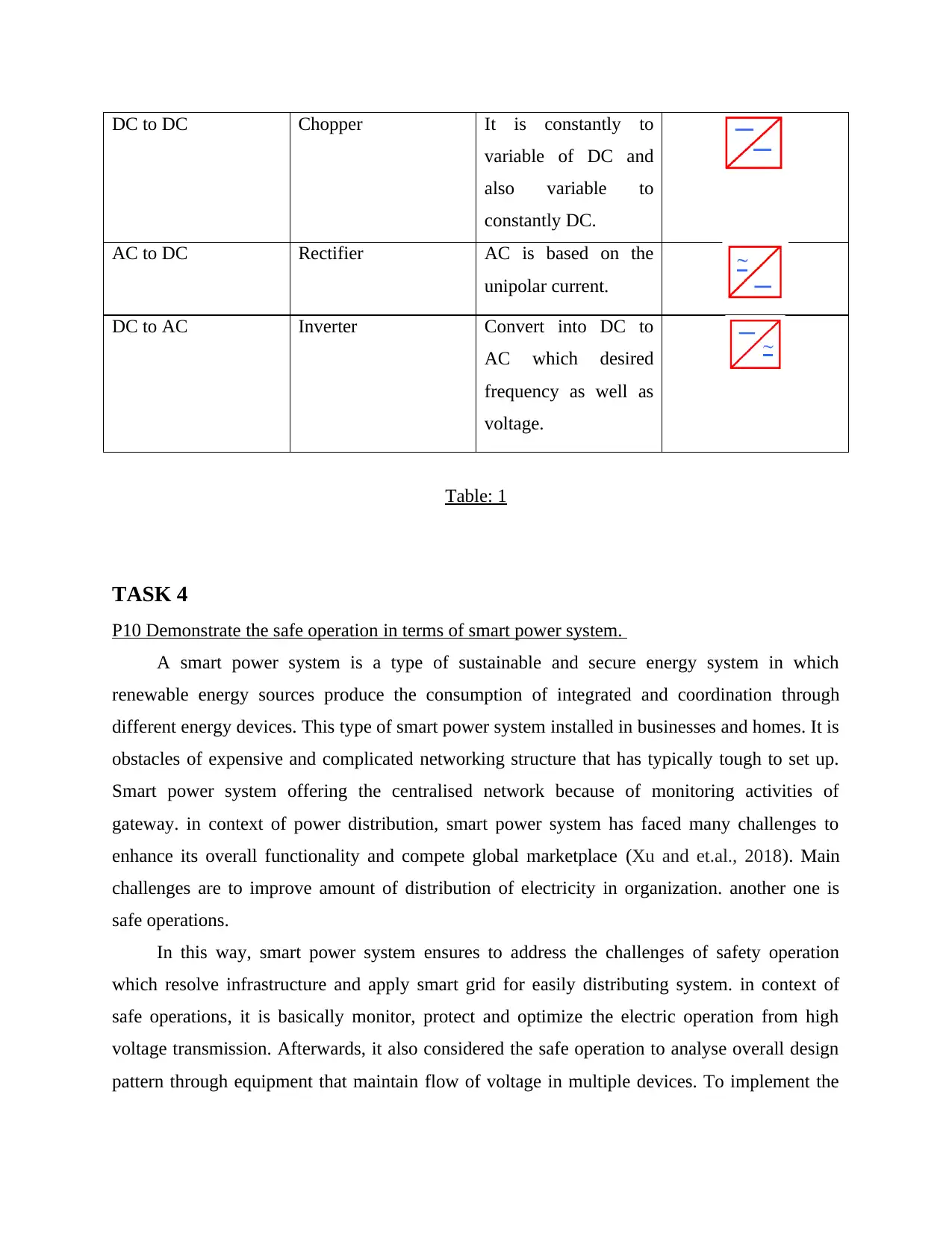
DC to DC Chopper It is constantly to
variable of DC and
also variable to
constantly DC.
AC to DC Rectifier AC is based on the
unipolar current.
DC to AC Inverter Convert into DC to
AC which desired
frequency as well as
voltage.
Table: 1
TASK 4
P10 Demonstrate the safe operation in terms of smart power system.
A smart power system is a type of sustainable and secure energy system in which
renewable energy sources produce the consumption of integrated and coordination through
different energy devices. This type of smart power system installed in businesses and homes. It is
obstacles of expensive and complicated networking structure that has typically tough to set up.
Smart power system offering the centralised network because of monitoring activities of
gateway. in context of power distribution, smart power system has faced many challenges to
enhance its overall functionality and compete global marketplace (Xu and et.al., 2018). Main
challenges are to improve amount of distribution of electricity in organization. another one is
safe operations.
In this way, smart power system ensures to address the challenges of safety operation
which resolve infrastructure and apply smart grid for easily distributing system. in context of
safe operations, it is basically monitor, protect and optimize the electric operation from high
voltage transmission. Afterwards, it also considered the safe operation to analyse overall design
pattern through equipment that maintain flow of voltage in multiple devices. To implement the
variable of DC and
also variable to
constantly DC.
AC to DC Rectifier AC is based on the
unipolar current.
DC to AC Inverter Convert into DC to
AC which desired
frequency as well as
voltage.
Table: 1
TASK 4
P10 Demonstrate the safe operation in terms of smart power system.
A smart power system is a type of sustainable and secure energy system in which
renewable energy sources produce the consumption of integrated and coordination through
different energy devices. This type of smart power system installed in businesses and homes. It is
obstacles of expensive and complicated networking structure that has typically tough to set up.
Smart power system offering the centralised network because of monitoring activities of
gateway. in context of power distribution, smart power system has faced many challenges to
enhance its overall functionality and compete global marketplace (Xu and et.al., 2018). Main
challenges are to improve amount of distribution of electricity in organization. another one is
safe operations.
In this way, smart power system ensures to address the challenges of safety operation
which resolve infrastructure and apply smart grid for easily distributing system. in context of
safe operations, it is basically monitor, protect and optimize the electric operation from high
voltage transmission. Afterwards, it also considered the safe operation to analyse overall design
pattern through equipment that maintain flow of voltage in multiple devices. To implement the
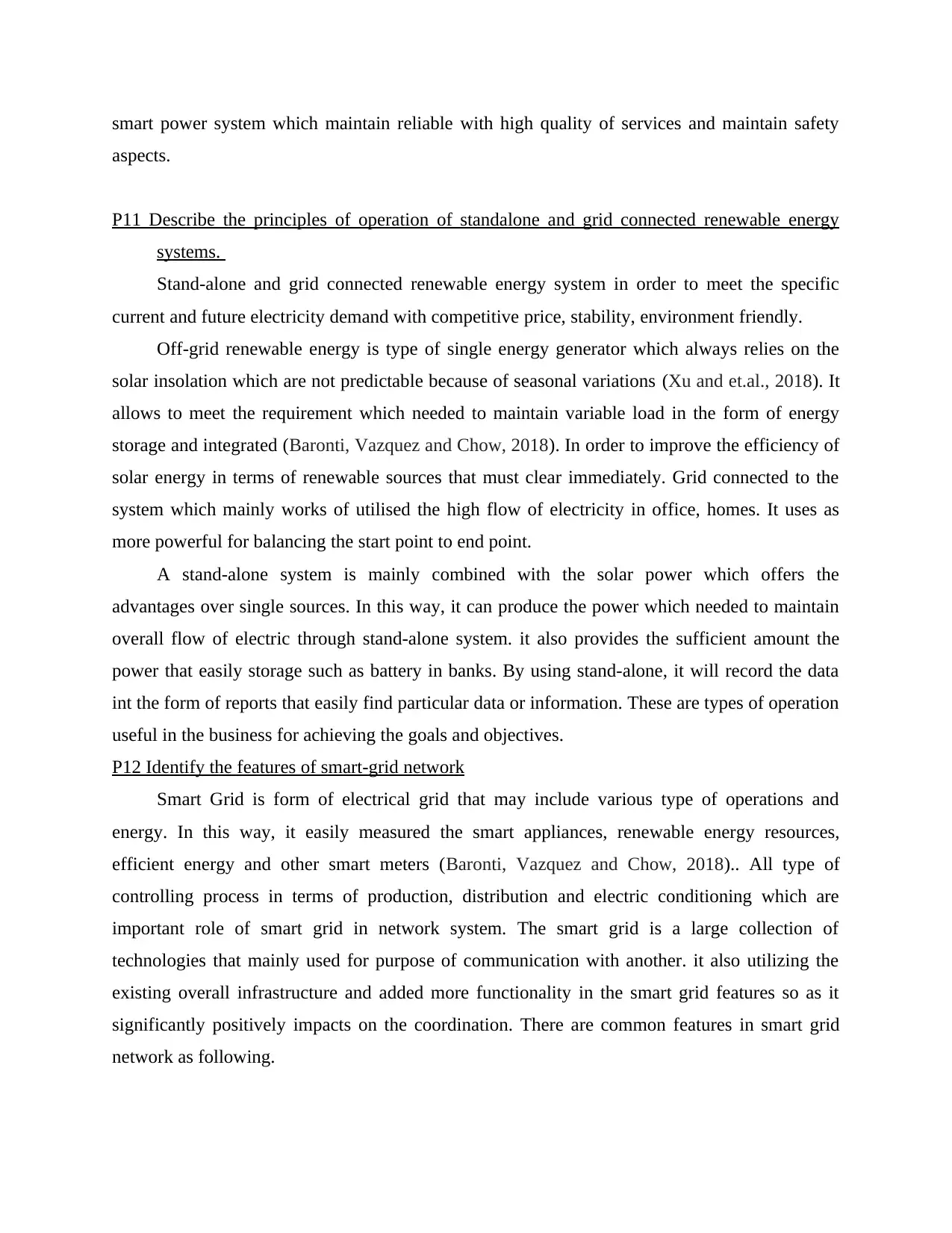
smart power system which maintain reliable with high quality of services and maintain safety
aspects.
P11 Describe the principles of operation of standalone and grid connected renewable energy
systems.
Stand-alone and grid connected renewable energy system in order to meet the specific
current and future electricity demand with competitive price, stability, environment friendly.
Off-grid renewable energy is type of single energy generator which always relies on the
solar insolation which are not predictable because of seasonal variations (Xu and et.al., 2018). It
allows to meet the requirement which needed to maintain variable load in the form of energy
storage and integrated (Baronti, Vazquez and Chow, 2018). In order to improve the efficiency of
solar energy in terms of renewable sources that must clear immediately. Grid connected to the
system which mainly works of utilised the high flow of electricity in office, homes. It uses as
more powerful for balancing the start point to end point.
A stand-alone system is mainly combined with the solar power which offers the
advantages over single sources. In this way, it can produce the power which needed to maintain
overall flow of electric through stand-alone system. it also provides the sufficient amount the
power that easily storage such as battery in banks. By using stand-alone, it will record the data
int the form of reports that easily find particular data or information. These are types of operation
useful in the business for achieving the goals and objectives.
P12 Identify the features of smart-grid network
Smart Grid is form of electrical grid that may include various type of operations and
energy. In this way, it easily measured the smart appliances, renewable energy resources,
efficient energy and other smart meters (Baronti, Vazquez and Chow, 2018).. All type of
controlling process in terms of production, distribution and electric conditioning which are
important role of smart grid in network system. The smart grid is a large collection of
technologies that mainly used for purpose of communication with another. it also utilizing the
existing overall infrastructure and added more functionality in the smart grid features so as it
significantly positively impacts on the coordination. There are common features in smart grid
network as following.
aspects.
P11 Describe the principles of operation of standalone and grid connected renewable energy
systems.
Stand-alone and grid connected renewable energy system in order to meet the specific
current and future electricity demand with competitive price, stability, environment friendly.
Off-grid renewable energy is type of single energy generator which always relies on the
solar insolation which are not predictable because of seasonal variations (Xu and et.al., 2018). It
allows to meet the requirement which needed to maintain variable load in the form of energy
storage and integrated (Baronti, Vazquez and Chow, 2018). In order to improve the efficiency of
solar energy in terms of renewable sources that must clear immediately. Grid connected to the
system which mainly works of utilised the high flow of electricity in office, homes. It uses as
more powerful for balancing the start point to end point.
A stand-alone system is mainly combined with the solar power which offers the
advantages over single sources. In this way, it can produce the power which needed to maintain
overall flow of electric through stand-alone system. it also provides the sufficient amount the
power that easily storage such as battery in banks. By using stand-alone, it will record the data
int the form of reports that easily find particular data or information. These are types of operation
useful in the business for achieving the goals and objectives.
P12 Identify the features of smart-grid network
Smart Grid is form of electrical grid that may include various type of operations and
energy. In this way, it easily measured the smart appliances, renewable energy resources,
efficient energy and other smart meters (Baronti, Vazquez and Chow, 2018).. All type of
controlling process in terms of production, distribution and electric conditioning which are
important role of smart grid in network system. The smart grid is a large collection of
technologies that mainly used for purpose of communication with another. it also utilizing the
existing overall infrastructure and added more functionality in the smart grid features so as it
significantly positively impacts on the coordination. There are common features in smart grid
network as following.
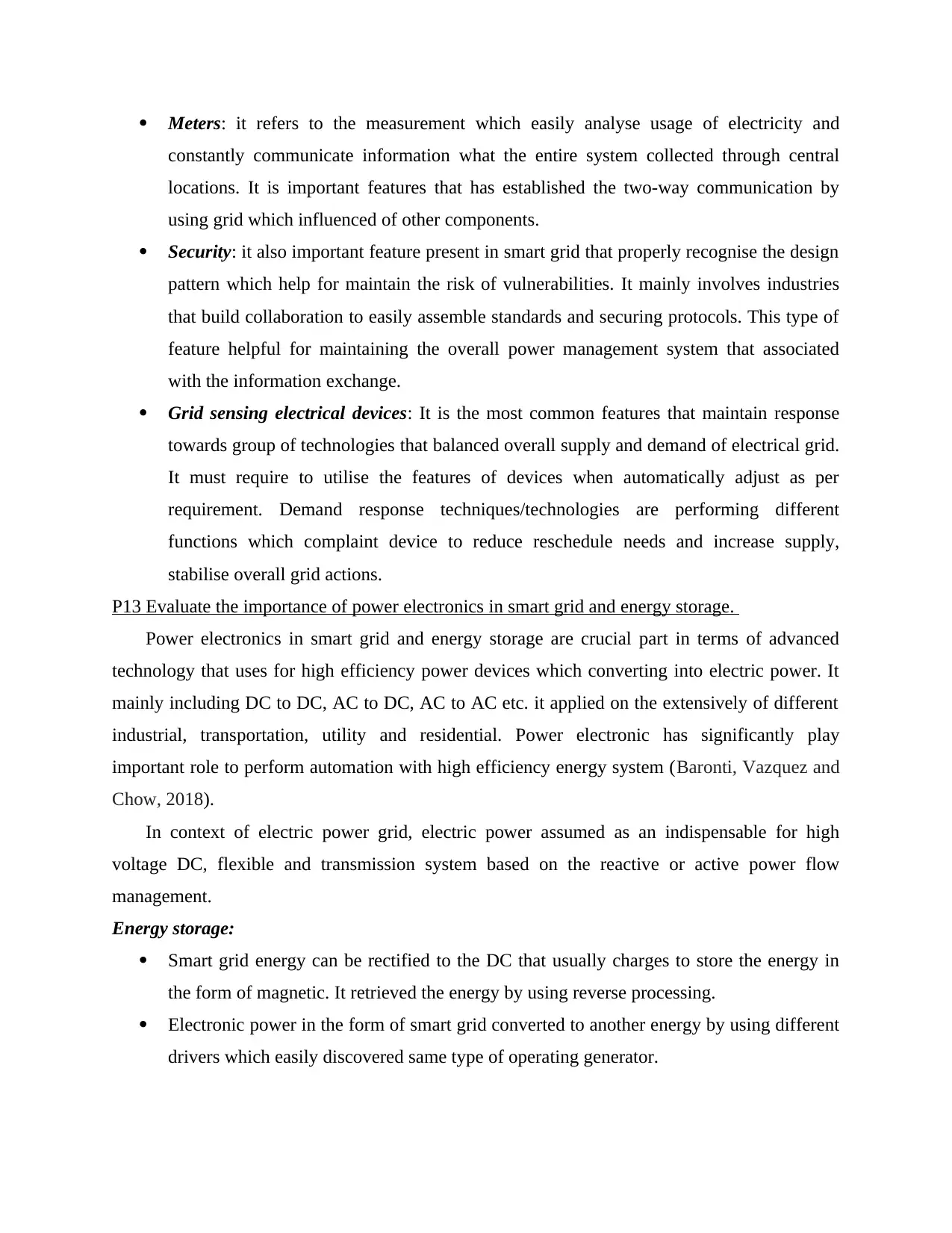
Meters: it refers to the measurement which easily analyse usage of electricity and
constantly communicate information what the entire system collected through central
locations. It is important features that has established the two-way communication by
using grid which influenced of other components.
Security: it also important feature present in smart grid that properly recognise the design
pattern which help for maintain the risk of vulnerabilities. It mainly involves industries
that build collaboration to easily assemble standards and securing protocols. This type of
feature helpful for maintaining the overall power management system that associated
with the information exchange.
Grid sensing electrical devices: It is the most common features that maintain response
towards group of technologies that balanced overall supply and demand of electrical grid.
It must require to utilise the features of devices when automatically adjust as per
requirement. Demand response techniques/technologies are performing different
functions which complaint device to reduce reschedule needs and increase supply,
stabilise overall grid actions.
P13 Evaluate the importance of power electronics in smart grid and energy storage.
Power electronics in smart grid and energy storage are crucial part in terms of advanced
technology that uses for high efficiency power devices which converting into electric power. It
mainly including DC to DC, AC to DC, AC to AC etc. it applied on the extensively of different
industrial, transportation, utility and residential. Power electronic has significantly play
important role to perform automation with high efficiency energy system (Baronti, Vazquez and
Chow, 2018).
In context of electric power grid, electric power assumed as an indispensable for high
voltage DC, flexible and transmission system based on the reactive or active power flow
management.
Energy storage:
Smart grid energy can be rectified to the DC that usually charges to store the energy in
the form of magnetic. It retrieved the energy by using reverse processing.
Electronic power in the form of smart grid converted to another energy by using different
drivers which easily discovered same type of operating generator.
constantly communicate information what the entire system collected through central
locations. It is important features that has established the two-way communication by
using grid which influenced of other components.
Security: it also important feature present in smart grid that properly recognise the design
pattern which help for maintain the risk of vulnerabilities. It mainly involves industries
that build collaboration to easily assemble standards and securing protocols. This type of
feature helpful for maintaining the overall power management system that associated
with the information exchange.
Grid sensing electrical devices: It is the most common features that maintain response
towards group of technologies that balanced overall supply and demand of electrical grid.
It must require to utilise the features of devices when automatically adjust as per
requirement. Demand response techniques/technologies are performing different
functions which complaint device to reduce reschedule needs and increase supply,
stabilise overall grid actions.
P13 Evaluate the importance of power electronics in smart grid and energy storage.
Power electronics in smart grid and energy storage are crucial part in terms of advanced
technology that uses for high efficiency power devices which converting into electric power. It
mainly including DC to DC, AC to DC, AC to AC etc. it applied on the extensively of different
industrial, transportation, utility and residential. Power electronic has significantly play
important role to perform automation with high efficiency energy system (Baronti, Vazquez and
Chow, 2018).
In context of electric power grid, electric power assumed as an indispensable for high
voltage DC, flexible and transmission system based on the reactive or active power flow
management.
Energy storage:
Smart grid energy can be rectified to the DC that usually charges to store the energy in
the form of magnetic. It retrieved the energy by using reverse processing.
Electronic power in the form of smart grid converted to another energy by using different
drivers which easily discovered same type of operating generator.
Secure Best Marks with AI Grader
Need help grading? Try our AI Grader for instant feedback on your assignments.
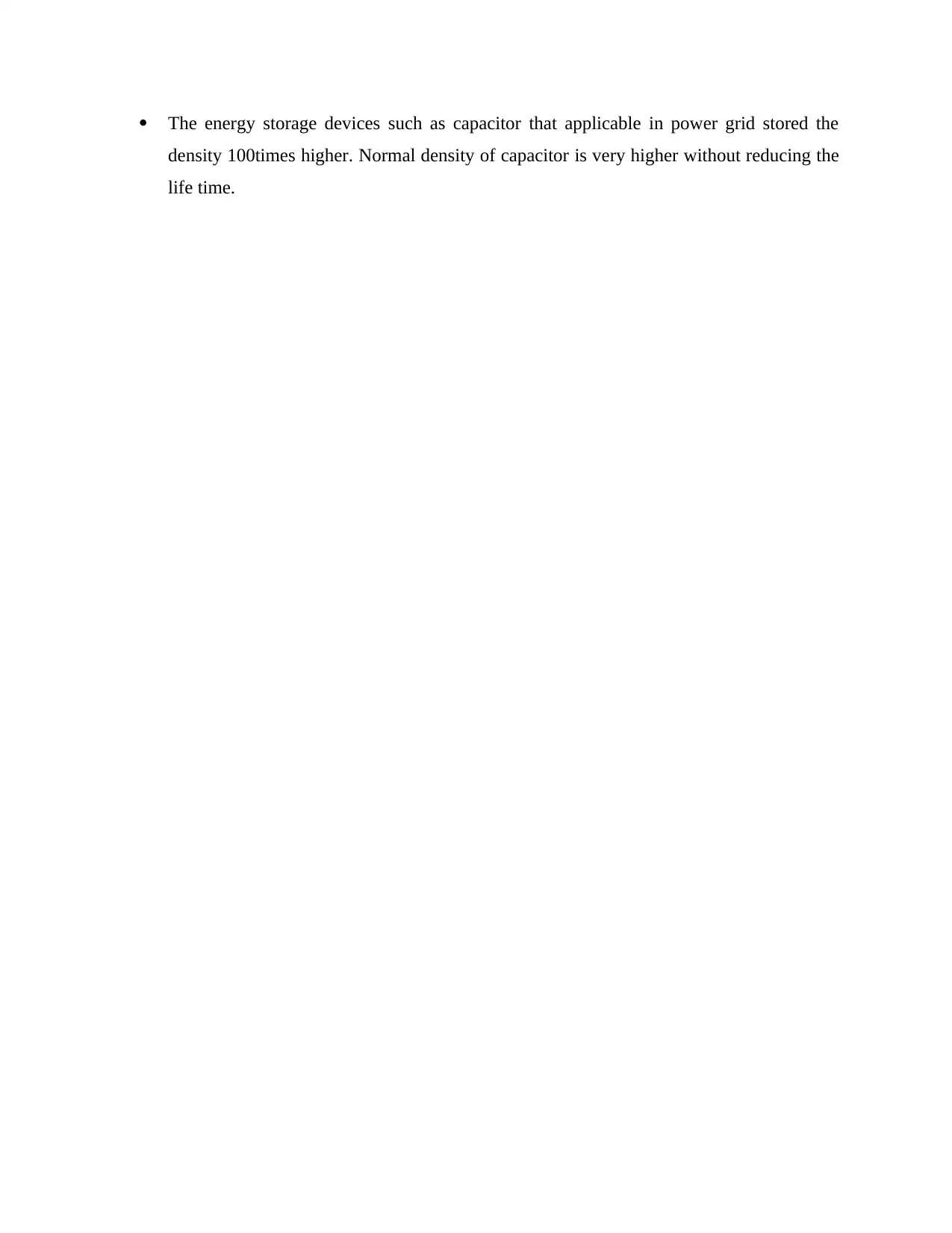
The energy storage devices such as capacitor that applicable in power grid stored the
density 100times higher. Normal density of capacitor is very higher without reducing the
life time.
density 100times higher. Normal density of capacitor is very higher without reducing the
life time.
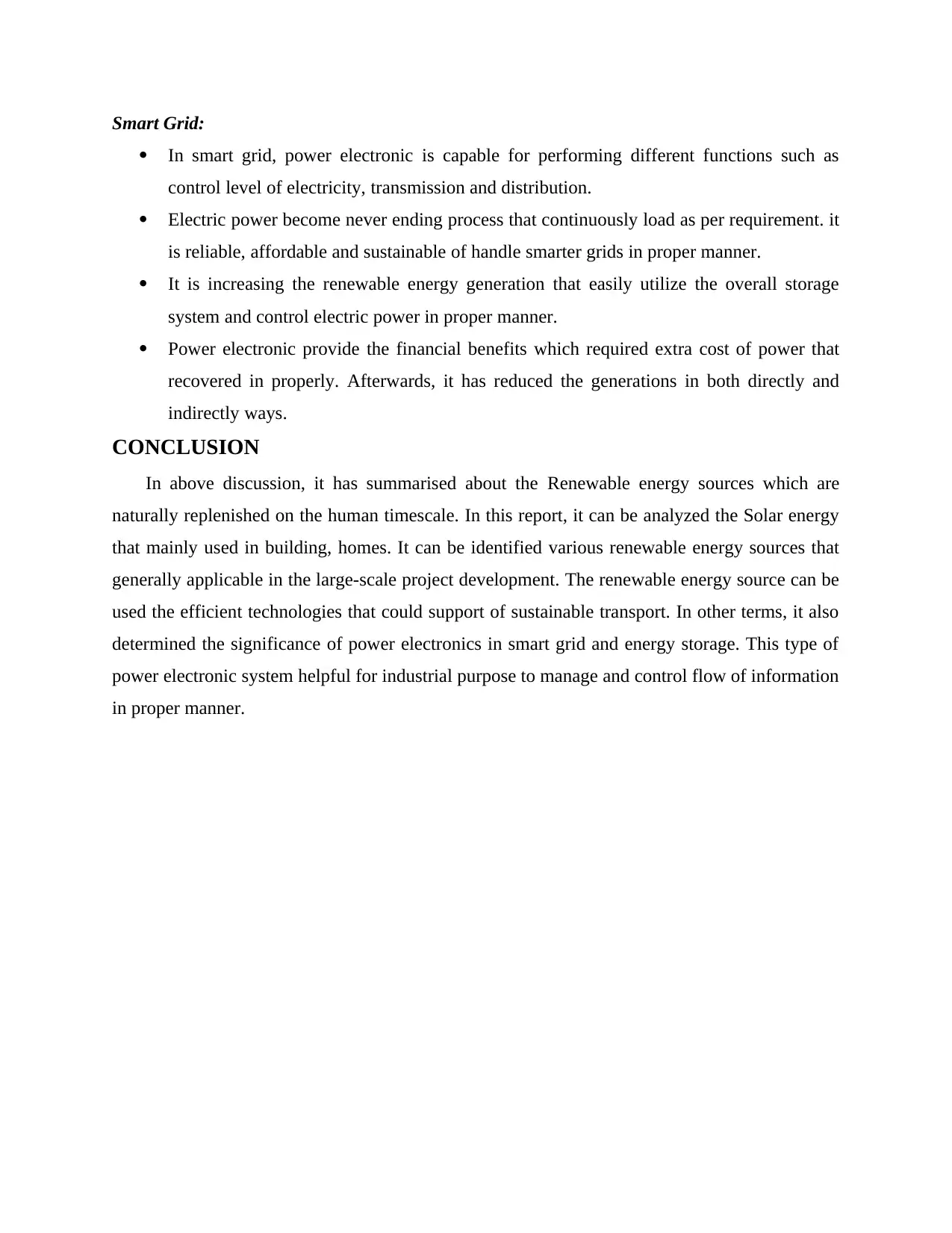
Smart Grid:
In smart grid, power electronic is capable for performing different functions such as
control level of electricity, transmission and distribution.
Electric power become never ending process that continuously load as per requirement. it
is reliable, affordable and sustainable of handle smarter grids in proper manner.
It is increasing the renewable energy generation that easily utilize the overall storage
system and control electric power in proper manner.
Power electronic provide the financial benefits which required extra cost of power that
recovered in properly. Afterwards, it has reduced the generations in both directly and
indirectly ways.
CONCLUSION
In above discussion, it has summarised about the Renewable energy sources which are
naturally replenished on the human timescale. In this report, it can be analyzed the Solar energy
that mainly used in building, homes. It can be identified various renewable energy sources that
generally applicable in the large-scale project development. The renewable energy source can be
used the efficient technologies that could support of sustainable transport. In other terms, it also
determined the significance of power electronics in smart grid and energy storage. This type of
power electronic system helpful for industrial purpose to manage and control flow of information
in proper manner.
In smart grid, power electronic is capable for performing different functions such as
control level of electricity, transmission and distribution.
Electric power become never ending process that continuously load as per requirement. it
is reliable, affordable and sustainable of handle smarter grids in proper manner.
It is increasing the renewable energy generation that easily utilize the overall storage
system and control electric power in proper manner.
Power electronic provide the financial benefits which required extra cost of power that
recovered in properly. Afterwards, it has reduced the generations in both directly and
indirectly ways.
CONCLUSION
In above discussion, it has summarised about the Renewable energy sources which are
naturally replenished on the human timescale. In this report, it can be analyzed the Solar energy
that mainly used in building, homes. It can be identified various renewable energy sources that
generally applicable in the large-scale project development. The renewable energy source can be
used the efficient technologies that could support of sustainable transport. In other terms, it also
determined the significance of power electronics in smart grid and energy storage. This type of
power electronic system helpful for industrial purpose to manage and control flow of information
in proper manner.
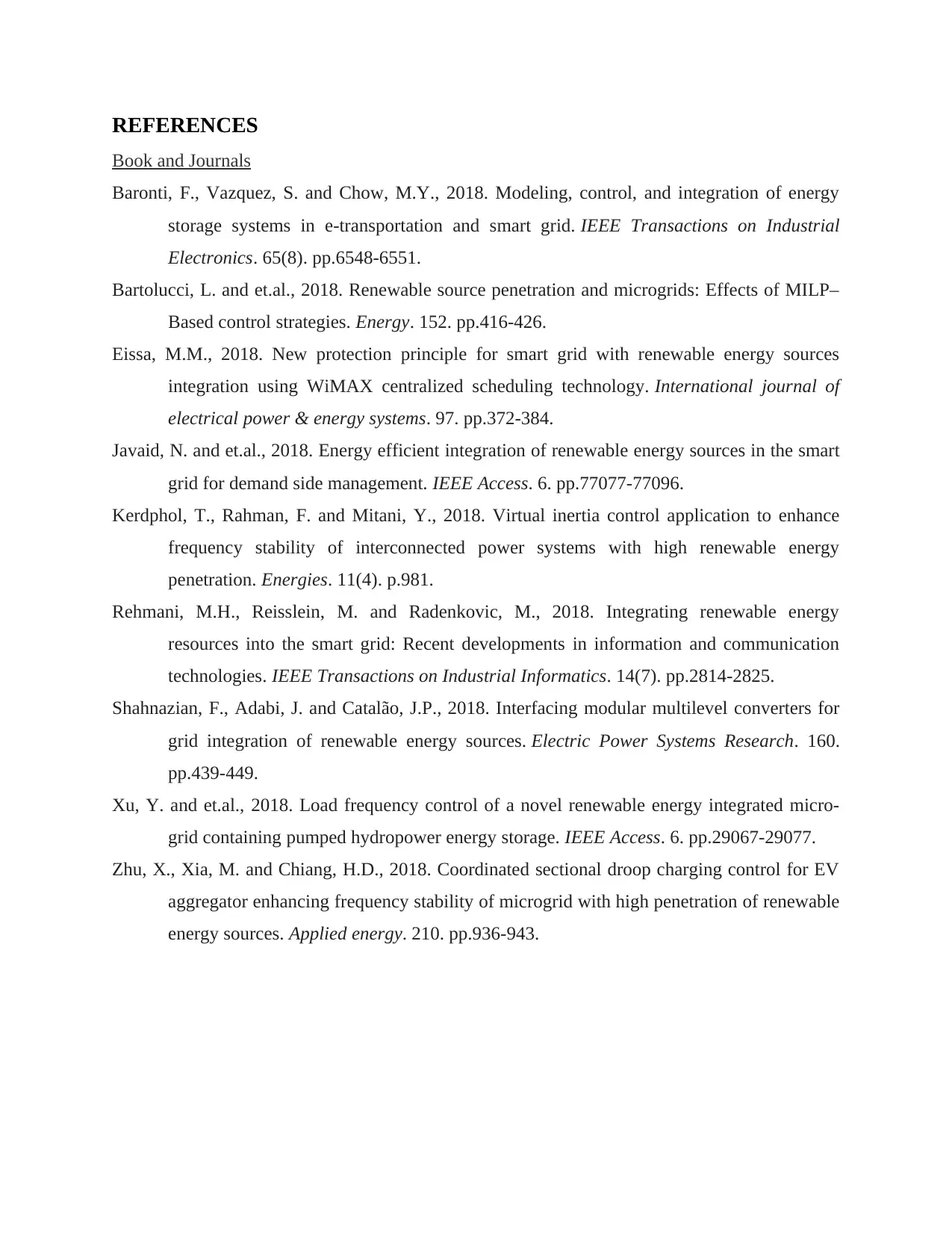
REFERENCES
Book and Journals
Baronti, F., Vazquez, S. and Chow, M.Y., 2018. Modeling, control, and integration of energy
storage systems in e-transportation and smart grid. IEEE Transactions on Industrial
Electronics. 65(8). pp.6548-6551.
Bartolucci, L. and et.al., 2018. Renewable source penetration and microgrids: Effects of MILP–
Based control strategies. Energy. 152. pp.416-426.
Eissa, M.M., 2018. New protection principle for smart grid with renewable energy sources
integration using WiMAX centralized scheduling technology. International journal of
electrical power & energy systems. 97. pp.372-384.
Javaid, N. and et.al., 2018. Energy efficient integration of renewable energy sources in the smart
grid for demand side management. IEEE Access. 6. pp.77077-77096.
Kerdphol, T., Rahman, F. and Mitani, Y., 2018. Virtual inertia control application to enhance
frequency stability of interconnected power systems with high renewable energy
penetration. Energies. 11(4). p.981.
Rehmani, M.H., Reisslein, M. and Radenkovic, M., 2018. Integrating renewable energy
resources into the smart grid: Recent developments in information and communication
technologies. IEEE Transactions on Industrial Informatics. 14(7). pp.2814-2825.
Shahnazian, F., Adabi, J. and Catalão, J.P., 2018. Interfacing modular multilevel converters for
grid integration of renewable energy sources. Electric Power Systems Research. 160.
pp.439-449.
Xu, Y. and et.al., 2018. Load frequency control of a novel renewable energy integrated micro-
grid containing pumped hydropower energy storage. IEEE Access. 6. pp.29067-29077.
Zhu, X., Xia, M. and Chiang, H.D., 2018. Coordinated sectional droop charging control for EV
aggregator enhancing frequency stability of microgrid with high penetration of renewable
energy sources. Applied energy. 210. pp.936-943.
Book and Journals
Baronti, F., Vazquez, S. and Chow, M.Y., 2018. Modeling, control, and integration of energy
storage systems in e-transportation and smart grid. IEEE Transactions on Industrial
Electronics. 65(8). pp.6548-6551.
Bartolucci, L. and et.al., 2018. Renewable source penetration and microgrids: Effects of MILP–
Based control strategies. Energy. 152. pp.416-426.
Eissa, M.M., 2018. New protection principle for smart grid with renewable energy sources
integration using WiMAX centralized scheduling technology. International journal of
electrical power & energy systems. 97. pp.372-384.
Javaid, N. and et.al., 2018. Energy efficient integration of renewable energy sources in the smart
grid for demand side management. IEEE Access. 6. pp.77077-77096.
Kerdphol, T., Rahman, F. and Mitani, Y., 2018. Virtual inertia control application to enhance
frequency stability of interconnected power systems with high renewable energy
penetration. Energies. 11(4). p.981.
Rehmani, M.H., Reisslein, M. and Radenkovic, M., 2018. Integrating renewable energy
resources into the smart grid: Recent developments in information and communication
technologies. IEEE Transactions on Industrial Informatics. 14(7). pp.2814-2825.
Shahnazian, F., Adabi, J. and Catalão, J.P., 2018. Interfacing modular multilevel converters for
grid integration of renewable energy sources. Electric Power Systems Research. 160.
pp.439-449.
Xu, Y. and et.al., 2018. Load frequency control of a novel renewable energy integrated micro-
grid containing pumped hydropower energy storage. IEEE Access. 6. pp.29067-29077.
Zhu, X., Xia, M. and Chiang, H.D., 2018. Coordinated sectional droop charging control for EV
aggregator enhancing frequency stability of microgrid with high penetration of renewable
energy sources. Applied energy. 210. pp.936-943.
Paraphrase This Document
Need a fresh take? Get an instant paraphrase of this document with our AI Paraphraser



1
1 out of 16
Related Documents
Your All-in-One AI-Powered Toolkit for Academic Success.
+13062052269
info@desklib.com
Available 24*7 on WhatsApp / Email
![[object Object]](/_next/static/media/star-bottom.7253800d.svg)
Unlock your academic potential
© 2024 | Zucol Services PVT LTD | All rights reserved.





